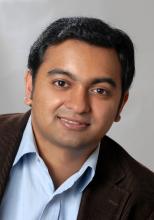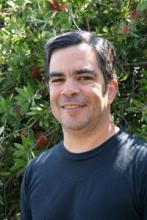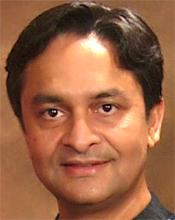Negative Capacitance Transistors

Dr. Sayeef Salahuddin
Associate Professor
Electrical Engineering and Computer Science, UC Berkeley
Thu, 11/19/2015
Abstract – Phase transition materials have long been investigated for fundamental physics and also for potential application in electronics. In this presentation, I shall discuss how a controlled phase transition can lead to fundamentally new switching devices that has significantly less energy dissipation compared to the state of the art. In particular, I shall talk about the state of negative capacitance that can be achieved in certain material systems with stored energy of phase transition. Our recent experiments with ferroelectric materials have shown that such a state of negative capacitance can actually be achieved. I shall also describe our very recent results where such negative capacitance, when combined with conventional transistors, lead to effects that was long believed to be impossible. Finally, I shall discuss how these effects can usher in a new era of energy efficient electronics. with design considerations for PCB materials and the corresponding fabrication processes.
Dr. Sayeef Salahuddin is an associate professor of Electrical Engineering and Computer Sciences at the University of California, Berkeley. His research interests are in the interdisciplinary field of electronic transport in nanostructures currently focusing on novel electronic and spintronic devices for low power logic and memory applications. Salahuddin received a number of awards including the NSF CAREER award, the IEEE Nanotechnology Early Career Award, the Young Investigator Awards from the AFOSR and the ARO and best paper awards from IEEE Transactions on VLSI Systems and from the VLSI-TSA conference. He is on the editorial board of IEEE Electron Devices Letters and currently chairs the Electron Devices Society committee on Nanotechnology.
Overview of Distributed RF/Microwave Filters and Design for RF Systems in the AWR Design Environment

Mr. Drew Fischer
Staff Hardware Engineer
RF Microwave R&D, National Instruments
Thu, 11/05/2015
Abstract - Filters are key components in RF and microwave systems. At higher operating frequencies, filter design becomes increasingly difficult to implement using lumped components and the use of distributed-element filters is required. To successfully design these filters, the proper use of simulation tools is necessary. Designers must also understand and select appropriate filter technologies to meet performance goals. In order to reduce cost and take advantage of standardized processes, filter implementation on printed circuit board material can be used. A survey of the AWR Design Environment (AWRDE) is presented, including an overview of the various simulators – Microwave Office, AXIEM, Analyst – and their respective uses. Example designs of distributed filters are used to demonstrate the design flow within the AWRDE and highlight aspects of filter design while seamlessly moving between tools. An overview of distributed filters is also discussed along with design considerations for PCB materials and the corresponding fabrication processes.
Mr. Drew Fischer is an RF/microwave hardware design engineer at National Instruments in Santa Rosa, CA, where he works on developing PXI modules for the Test & Measurement Industry. He received his bachelor’s and master’s degrees in electrical engineering from California Polytechnic State University in San Luis Obispo.
Innovation and Utility in Engineered Solutions - The Cerent Story

R.K. Koslowsky
Consultant
Thu, 10/15/2015
Abstract –Multi-service Provisioning Platforms (MSPPs) became a market-changing innovation, introduced to the transmission segment of the telecommunication network in 1998. The first company to introduce the MSPP was Cerent Corporation, based in Petaluma, California. The utility of Cerent’s product, as viewed by telecom operators, made it both a market success and a new standard to which all manufacturers adhered by 2001. Multi-service connectivity enabled the aggregation of numerous service interfaces to be transported across optical networks. The use of Application Specific Integrated Circuits (ASICs) was key to saving space and lowering power consumption. Adhering to current telecom standards and leveraging leading edge Graphical User Interface (GUI) software ensured the network element would fit into existing telecom operating environments. We will review how MSPPs, designed in Sonoma County, were a catalyst for innovation in the telecommunications network and how its utility won acceptance from telecoms on a global scale.
Mr. Robert K. Koslowsky spent more than 30 years in the high-technology field of optical fiber transmission systems and energy development. His degree in electrical engineering from the University of Manitoba enabled him to work at large telecom manufacturers such as Nortel and Cisco and innovate with a number of startups including Cerent, Caeren Systems, Enphase Energy, e- Locate, and Cyan. Rob served as an officer of the Redwood branch of the California Writers Club in the mid-2000s and has written on numerous technology and engineering topics. His second book, The Upstart Startup: How Cerent Transformed Cisco (2014), captures the story about the rise of an innovative telecom startup based here in Sonoma County. Rob is a member of the IEEE and the Northern California Science Writers Association and he serves on the board of the University of Manitoba USA Foundation.
Estimation of Rural Electricity Demand

Daniel Soto
Assistant Professor
Environmental Studies and Planning, SSU
Thu, 10/01/2015
Abstract – Approximately 20 percent of the world's population lacks access to electricity because the cost of constructing networks and power plants that can reach them is too high. Entrepreneurs are installing microgrids with solar or biomass energy generation that can provide power in some of these areas. These entrepreneurs must take a risk by installing most of the electricity equipment with private funding. This work is developing estimates of the electricity demand of a community after it is connected to a new electricity source using information about the community prior to electrification. An accurate estimate of this electricity use will help microgrid operators to install the right amount of equipment, improving the financial sustainability of the microgrid. By working at the intersection of engineering and social science, we hope to enable a more rapid pace of electrification.
Dr. Daniel Soto is an Assistant Professor in the Department of Environmental Studies and Planning at Sonoma State University. Daniel teaches classes on the intersection of energy and the environment and how to use energy more efficiently. His research focuses on ways to improve energy access in the developing world. Daniel earned his Ph.D. in Applied Physics at Stanford University. He also has an M.S. in Physics from San Francisco State University and a B.S. in Electrical Engineering from Stanford University. Prior to his return to academia, Daniel worked as an engineer at two startup companies creating optical micro-mechanical devices for laser displays and optical communications.
Peeling Atoms via Ultrasharp Nanostructures for Bio-Chemical-Environmental Sensing and Pollution Control

Dr. Saif Islam
Professor
Electrical and Computer Engineering, UC Davis
Thu, 09/17/2015
Abstract – Ultra-sharp nanostructures exhibit interesting functionalities in devices including gas ionization sensors, field emission devices, ion-mobility spectrometry, electrostatic precipitators and biological, chemical and agricultural sensors. We will present examples of engineered 1D semiconductor nanostructures in ultra-selective sensors and discuss their importance in chemical and biological detection; diagnosing medical symptoms of certain diseases; monitoring and controlling agricultural and industrial green house gas emission, indoor air quality of homes, public places, manufacturing plants, automotive emission, waste disposal and treatment plants. We will also show how such devices can dramatically reduce the design complexities of pollution monitoring and controlling systems. These devices enable new capabilities and offer great potential to be rationally tailored in a myriad of useful ways for accurate fingerprinting a broad range of biological and chemical analytes and for cost-effective control of environmental pollution.
Dr. Saif Islam received his B.Sc. Degree in Physics from Middle East Technical University (1994, Turkey), M.S. degree in Physics from Bilkent University (1996, Turkey) and Ph.D. degree in Electrical Engineering from the University of California – Los Angeles (UCLA, 2001). He worked for Hewlett-Packard Laboratories and JDS Uniphase Corporation before joining the Electrical and Computer Engineering Department of UC Davis in 2004, where he is now a Professor. His work covers ultra-fast nanoelectronic and photonic devices, molecular electronics, and integration of semiconductor nanostructures in devices and circuits for imaging, sensing, computing, energy conversion and storage. He has authored/co-authored more than 200 scientific papers, edited 24 books and conference proceedings and holds 38 patents as an inventor/co-inventor. Dr. Islam received NSF Faculty Early Career Award (2006), Outstanding Junior Faculty Award (2006), IEEE Professor of the Year (2005 and 2009), Mid-Career Research Faculty Award (2012) and Academic Senate Distinguished Teaching Award in 2010, the highest teaching honor University of California-Davis bestows on its faculties. He is a Fellow of National Academy of Inventors.